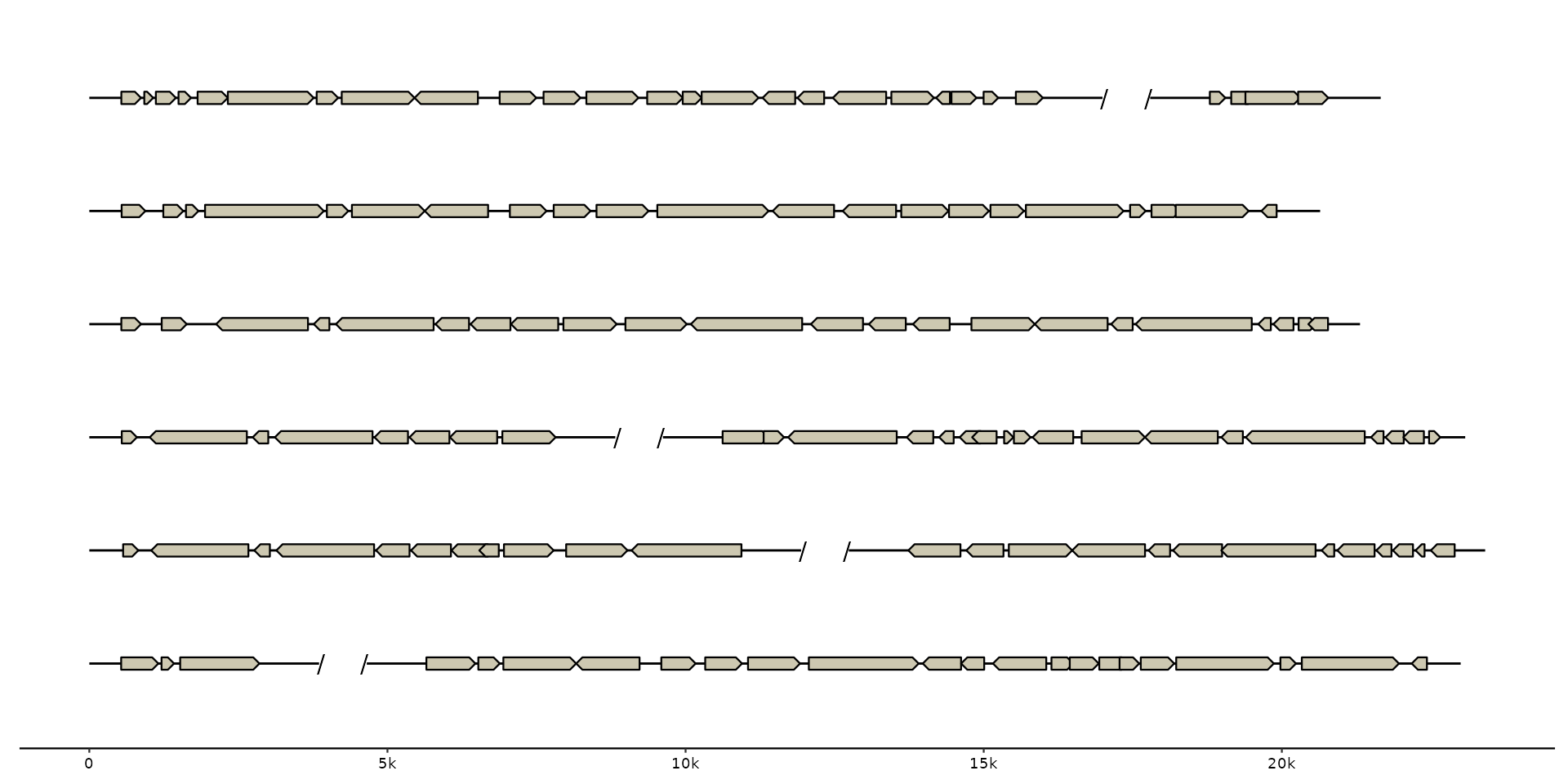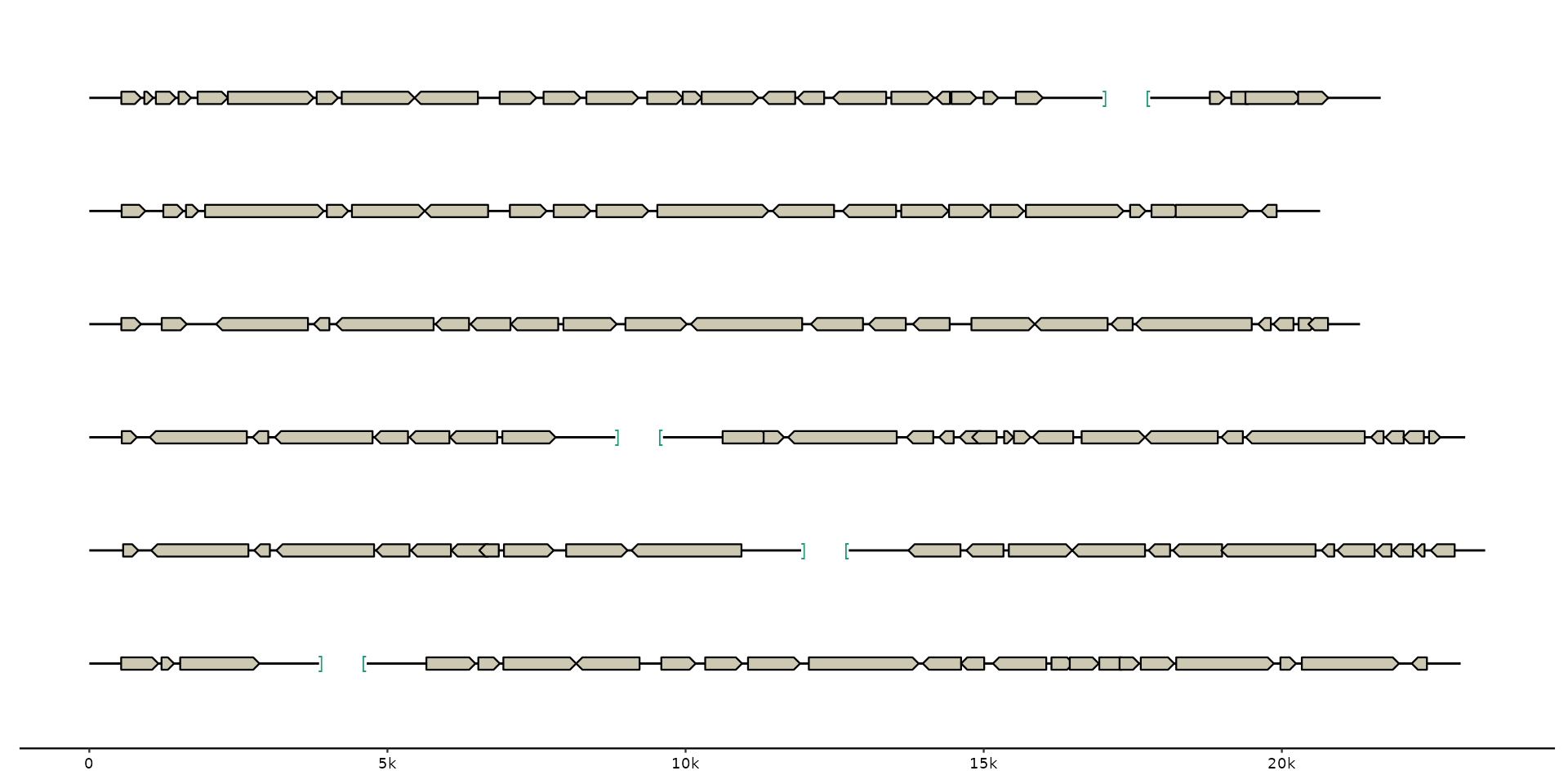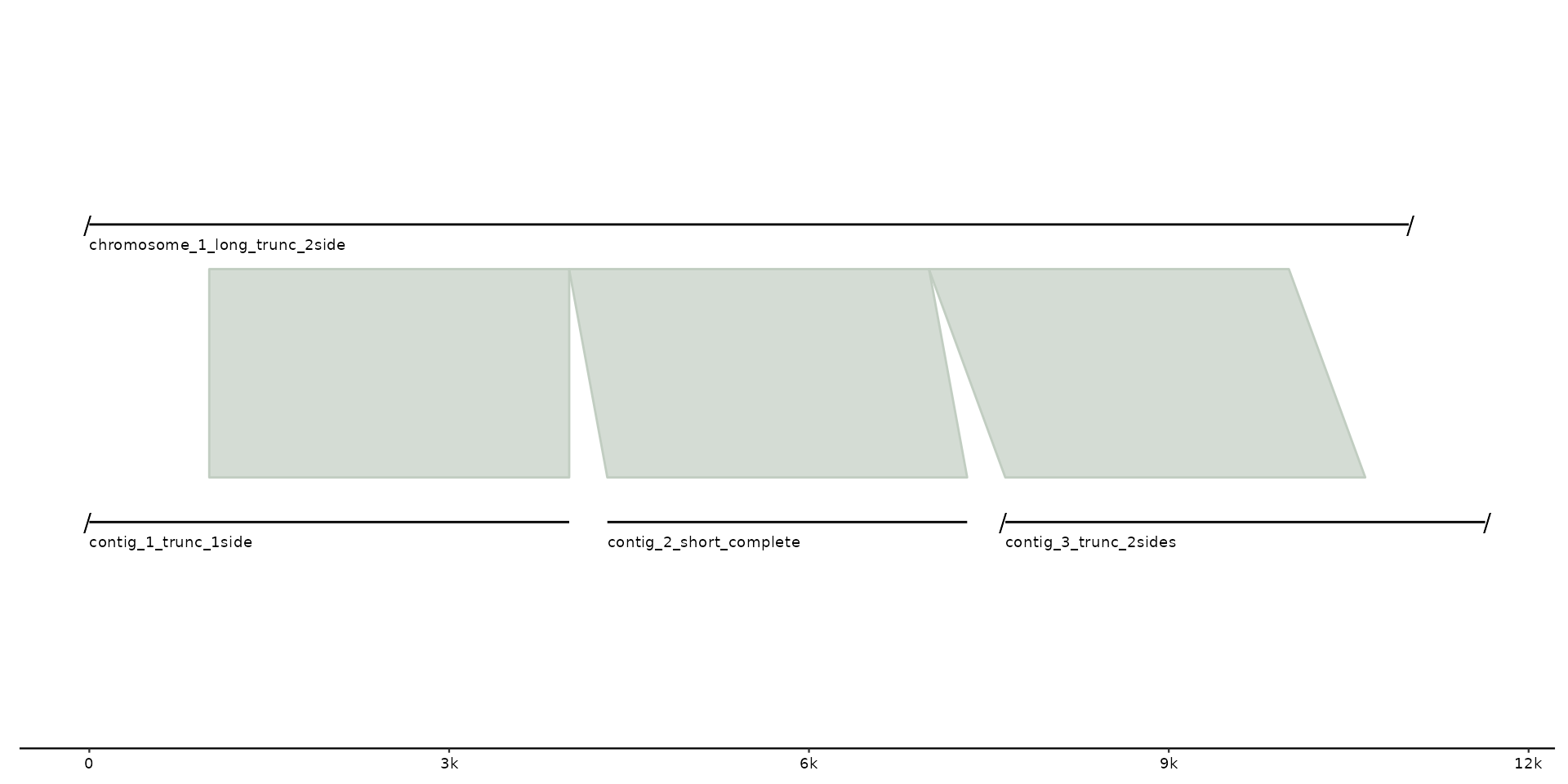geom_seq_break() adds decorations to the ends of truncated sequences. These
could arise from zooming onto sequence loci with focus(), or manually
annotating sequences with start > 1 and/or end < length.
Arguments
- mapping_start
optional start mapping
- mapping_end
optional end mapping
- data_start
seq_layout of sequences for which to decorate the start. default:
seqs(start >1)- data_end
seq_layout of sequences for which to decorate the end. default:
seqs(end < length)- label
the character to decorate ends with. Provide two values for different start and end decorations, e.g.
label=c("]", "[").- size
of the text
- hjust
Moves the text horizontally
- family
font family of the text
- stat
The statistical transformation to use on the data for this layer. When using a
geom_*()function to construct a layer, thestatargument can be used to override the default coupling between geoms and stats. Thestatargument accepts the following:A
Statggproto subclass, for exampleStatCount.A string naming the stat. To give the stat as a string, strip the function name of the
stat_prefix. For example, to usestat_count(), give the stat as"count".For more information and other ways to specify the stat, see the layer stat documentation.
- na.rm
If
FALSE, the default, missing values are removed with a warning. IfTRUE, missing values are silently removed.- show.legend
logical. Should this layer be included in the legends?
NA, the default, includes if any aesthetics are mapped.FALSEnever includes, andTRUEalways includes. It can also be a named logical vector to finely select the aesthetics to display. To include legend keys for all levels, even when no data exists, useTRUE. IfNA, all levels are shown in legend, but unobserved levels are omitted.- inherit.aes
If
FALSE, overrides the default aesthetics, rather than combining with them. This is most useful for helper functions that define both data and aesthetics and shouldn't inherit behaviour from the default plot specification, e.g.annotation_borders().- ...
Other arguments passed on to
layer()'sparamsargument. These arguments broadly fall into one of 4 categories below. Notably, further arguments to thepositionargument, or aesthetics that are required can not be passed through.... Unknown arguments that are not part of the 4 categories below are ignored.Static aesthetics that are not mapped to a scale, but are at a fixed value and apply to the layer as a whole. For example,
colour = "red"orlinewidth = 3. The geom's documentation has an Aesthetics section that lists the available options. The 'required' aesthetics cannot be passed on to theparams. Please note that while passing unmapped aesthetics as vectors is technically possible, the order and required length is not guaranteed to be parallel to the input data.When constructing a layer using a
stat_*()function, the...argument can be used to pass on parameters to thegeompart of the layer. An example of this isstat_density(geom = "area", outline.type = "both"). The geom's documentation lists which parameters it can accept.Inversely, when constructing a layer using a
geom_*()function, the...argument can be used to pass on parameters to thestatpart of the layer. An example of this isgeom_area(stat = "density", adjust = 0.5). The stat's documentation lists which parameters it can accept.The
key_glyphargument oflayer()may also be passed on through.... This can be one of the functions described as key glyphs, to change the display of the layer in the legend.
Examples
# decorate breaks created with focus()
gggenomes(emale_genes, emale_seqs) |>
focus(.expand = 1e3, .max_dist = 1e3) +
geom_seq() + geom_gene() +
geom_seq_break()
#> Showing 10 loci with the following size distribution
#> • min: 3853
#> • q25: 9284
#> • med: 12695
#> • q75: 18007
#> • max: 21311
 # customize decorations
gggenomes(emale_genes, emale_seqs) |>
focus(.expand = 1e3, .max_dist = 1e3) +
geom_seq() + geom_gene() +
geom_seq_break(label = c("[", "]"), size = 3, color = "#1b9e77")
#> Showing 10 loci with the following size distribution
#> • min: 3853
#> • q25: 9284
#> • med: 12695
#> • q75: 18007
#> • max: 21311
# customize decorations
gggenomes(emale_genes, emale_seqs) |>
focus(.expand = 1e3, .max_dist = 1e3) +
geom_seq() + geom_gene() +
geom_seq_break(label = c("[", "]"), size = 3, color = "#1b9e77")
#> Showing 10 loci with the following size distribution
#> • min: 3853
#> • q25: 9284
#> • med: 12695
#> • q75: 18007
#> • max: 21311
 # decorate manually truncated sequences
s0 <- tibble::tribble(
# start/end define regions, i.e. truncated contigs
~bin_id, ~seq_id, ~length, ~start, ~end,
"complete_genome", "chromosome_1_long_trunc_2side", 1e5, 1e4, 2.1e4,
"fragmented_assembly", "contig_1_trunc_1side", 1.3e4, .9e4, 1.3e4,
"fragmented_assembly", "contig_2_short_complete", 0.3e4, 1, 0.3e4,
"fragmented_assembly", "contig_3_trunc_2sides", 2e4, 1e4, 1.4e4
)
l0 <- tibble::tribble(
~seq_id, ~start, ~end, ~seq_id2, ~start2, ~end2,
"chromosome_1_long_trunc_2side", 1.1e4, 1.4e4,
"contig_1_trunc_1side", 1e4, 1.3e4,
"chromosome_1_long_trunc_2side", 1.4e4, 1.7e4,
"contig_2_short_complete", 1, 0.3e4,
"chromosome_1_long_trunc_2side", 1.7e4, 2e4,
"contig_3_trunc_2sides", 1e4, 1.3e4
)
gggenomes(seqs = s0, links = l0) +
geom_seq() + geom_link() +
geom_seq_label(nudge_y = -.05) +
geom_seq_break()
# decorate manually truncated sequences
s0 <- tibble::tribble(
# start/end define regions, i.e. truncated contigs
~bin_id, ~seq_id, ~length, ~start, ~end,
"complete_genome", "chromosome_1_long_trunc_2side", 1e5, 1e4, 2.1e4,
"fragmented_assembly", "contig_1_trunc_1side", 1.3e4, .9e4, 1.3e4,
"fragmented_assembly", "contig_2_short_complete", 0.3e4, 1, 0.3e4,
"fragmented_assembly", "contig_3_trunc_2sides", 2e4, 1e4, 1.4e4
)
l0 <- tibble::tribble(
~seq_id, ~start, ~end, ~seq_id2, ~start2, ~end2,
"chromosome_1_long_trunc_2side", 1.1e4, 1.4e4,
"contig_1_trunc_1side", 1e4, 1.3e4,
"chromosome_1_long_trunc_2side", 1.4e4, 1.7e4,
"contig_2_short_complete", 1, 0.3e4,
"chromosome_1_long_trunc_2side", 1.7e4, 2e4,
"contig_3_trunc_2sides", 1e4, 1.3e4
)
gggenomes(seqs = s0, links = l0) +
geom_seq() + geom_link() +
geom_seq_label(nudge_y = -.05) +
geom_seq_break()
